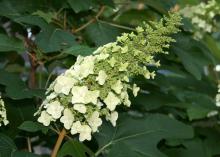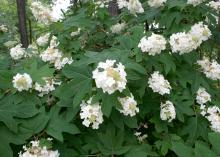Information Possibly Outdated
The information presented on this page was originally released on March 17, 2014. It may not be outdated, but please search our site for more current information. If you plan to quote or reference this information in a publication, please check with the Extension specialist or author before proceeding.
Oakleaf hydrangeas bring early spring flowers, color
The signs are all around us.
Red maples and redbuds are flowering, and yellow jessamine is scrambling and blooming along fences and way up in trees. This winter’s low temperatures have the ornamental pears really putting on a show.
Daylight Savings Time has kicked in, and we’re almost to the Spring Equinox. This can only mean one thing: Warmer weather has to show up sometime in the near future.
Flowering shrubs will soon take their turn brightening our gardens and landscape. Nothing can beat the show the Southern Indica azaleas put on. But there is one flowering shrub I look forward to more than others each year, and that is the oakleaf hydrangea. This shrub is a tough native plant that gets its common name from leaves shaped like oak leaves.
In Mississippi, oakleaf hydrangeas start blooming in early May and continue through the middle of June. If you’ve travelled along Interstate 20 between Jackson and Vicksburg, you’ve probably seen the white flowers blooming along the woodland hillsides.
The flowers are actually clusters made up of many smaller, individual flowers growing in cone-shaped clusters that can be up to a foot long. The showy, four-petal flowers are infertile and act as attractors to pollinators (and gardeners). The petals open snow white and transition to pink shades. The fertile flowers are inconspicuous in the flower clusters.
In 2000, Snowflake was selected as a Mississippi Medallion winner. The double flowers of this plant are excellent as cut flowers and can be dried for use in dry arrangements.
The coarse-textured foliage provides an excellent background for other plants that flower later in the summer gardening season. The foliage is a dark gray-green and has fall colors ranging from bronzy reds to oranges and browns. This is a deciduous shrub, and after the leaves drop in the fall, the upright branches expose exfoliating outer bark and cinnamon-tinged inner bark.
Oakleaf hydrangeas can be used as mass plantings. Plant them 7 to 8 feet apart to allow their natural shape and form to develop. Oakleaf hydrangeas are also fantastic specimens in the landscape, and they grow well in containers on the patio or porch.
Oakleaf hydrangeas grow best in well-drained, highly organic soils. Dig the planting hole twice as wide as the root ball, and mix good, aged compost with the soil from the hole. Set the plant only as deep as it was in the container. Current research shows that planting the crown a little higher than the surrounding soil improves drainage. Fill in the hole with amended soil and mulch with 2 to 3 inches of good organic mulch.
These hydrangeas perform best when planted in at least partial shade or filtered light from overhead trees. Consistent moisture is a must, but avoid overwatering at all costs. Oakleaf hydrangea tolerates pruning. Remove the tallest and any wayward branches by pruning at the base.
Use a good, slow-release fertilizer such as 14-14-14 for best results. Depending on plant size, spread 1/2 to 1 cup of the fertilizer around the plants in late March or the beginning of April to keep your oakleaf hydrangeas thriving.









